Latest recommendations

| Id | Title | Authors | Abstract | Picture | Thematic fields | Recommender | Reviewers▼ | Submission date | |
|---|---|---|---|---|---|---|---|---|---|
14 Sep 2020
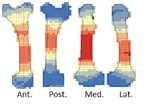
A way to break bones? The weight of intuitivenessDelphine Vettese, Trajanka Stavrova, Antony Borel, Juan Marin, Marie-Hélène Moncel, Marta Arzarello, Camille Daujeard https://doi.org/10.31219/osf.io/rebwtBreaking bones: Nature or Culture?Recommended by Beatrice Demarchi and Reuven Yeshurun based on reviews by Terry O'Connor, Alan Outram and 1 anonymous reviewerThe nature of breaking long bones for obtaining marrow is important in Paleolithic archaeology, due to its widespread, almost universal, character. Provided that hammer-stone percussion marks can be correctly identified using experimental datasets (e.g., [1]), the anatomical location and count of the marks may be taken to reflect recurrent “cultural” traditions in the Paleolithic [2]. Were MP humans breaking bones intuitively or did they abide by a strict “protocol”, and, if the latter, was this protocol optimized for marrow retrieval or geared towards another, less obvious goal? This paper provides a baseline for location analyses of percussion marks. Their dataset may therefore be regarded as a null hypothesis according to which the archaeological data could be tested. If Paleolithic patterns of percussion marks differ from Vettese et al.’s [3] “intuitive” patterns, then the null hypothesis is disproved and one can argue in favor of a learned pattern. The latter can be a result of ”culture”, as Vettese et al. [3] phrase it, in the sense of nonrandom action that draws on transmitted knowledge. Such comparisons bear a great potential for understanding the degree of technological behavior in the Paleolithic by factoring out the “natural” constraints of bone breakage patterns. Vettese et al. [3: fig. 14] started this discourse by comparing their experimental dataset to some Middle and Upper Paleolithic faunas; we are confident that many other studies will follow. Bibliography [1]Pickering, T.R., Egeland, C.P., 2006. Experimental patterns of hammerstone percussion damage on bones: Implications for inferences of carcass processing by humans. J. Archaeol. Sci. 33, 459–469. https://doi.org/10.1016/j.jas.2005.09.001 [2]Blasco, R., Rosell, J., Domínguez-Rodrigo, M., Lozano, S., Pastó, I., Riba, D., Vaquero, M., Peris, J.F., Arsuaga, J.L., de Castro, J.M.B., Carbonell, E., 2013. Learning by Heart: Cultural Patterns in the Faunal Processing Sequence during the Middle Pleistocene. PLoS One 8, e55863. https://doi.org/10.1371/journal.pone.0055863 [3]Vettese, D., Stavrova, T., Borel, A., Marin, J., Moncel, M.-H., Arzarello, M., Daujeard, C. (2020) A way to break bones? The weight of intuitiveness. BioRxiv, 011320, ver. 4 peer-reviewed and recommended by PCI Archaeology. https://doi.org/10.1101/2020.03.31.011320 | A way to break bones? The weight of intuitiveness | Delphine Vettese, Trajanka Stavrova, Antony Borel, Juan Marin, Marie-Hélène Moncel, Marta Arzarello, Camille Daujeard | <p>During the Middle Paleolithic period, bone marrow extraction was an essential source of fat nutrients for hunter-gatherers especially throughout cold and dry seasons. This is attested by the recurrent findings of percussion marks in osteologica... |  | Archaeometry, Bioarchaeology, Spatial analysis, Taphonomy, Zooarchaeology | Beatrice Demarchi | 2020-04-01 11:52:05 | View | |
28 May 2020

TIPZOO: a Touchscreen Interface for Palaeolithic Zooarchaeology. Towards making data entry and analysis easier, faster, and more reliableEmmanuel Discamps https://doi.org/10.31219/osf.io/aew5cA new software to improve standardization and quality of data in zooarchaeologyRecommended by Florent Rivals based on reviews by Delphine Vettese and Argant Thierry based on reviews by Delphine Vettese and Argant Thierry
Standardization and quality of data collection are identified as challenges for the future in zooarchaeology [1]. These issues were already identified in the early 1970s when the International Council for Archaeozoology (ICAZ) recommended to “standardize measurements and data in publications”. In the recent years, there is strong recommendations by publishers and grant to follow the FAIR Principle i.e. to “improve the findability, accessibility, interoperability, and reuse of digital assets” [2]. As zooarchaeologists, we should make our methods more clear and replicable by other researchers to produce comparable datasets. In this paper the authors make a significant step in proposing a tool to replace traditional data recording softwares. The problems related to data recording are clearly identified and discussed. All the features offered by TIPZOO allow to standardize the data, to reduce the errors when entering the data, to save time with auto-filling entries. The coding system used in TIPZOO is based on variables taken from the most used and updated literature in zooarchaeology. Its connections with various R packages allow to directly export the data and to transform the raw data to produce summary tables, graphs and basic statistics. Finally, the advantage of this tool is that it can be improved, debugged, or implemented at any time. TIPZOO provides a standardized system to compile and share large and consistent datasets that will allow comparison among assemblages at a large scale, and for this reason, I have recommended the work for PCI Archaeology. References [1] Steele, T.E. (2015). The contributions of animal bones from archaeological sites: the past and future of zooarchaeology. J. Archaeol. Sci. 56, 168–176. doi: 10.1016/j.jas.2015.02.036 | TIPZOO: a Touchscreen Interface for Palaeolithic Zooarchaeology. Towards making data entry and analysis easier, faster, and more reliable | Emmanuel Discamps | <p>Zooarchaeological studies of fossil bone collections are often conducted using simple spreadsheet programs for data recording and analysis. After quickly summarizing the limitations of such an approach, we present a new software solution, TIPZO... |  | Spatial analysis, Taphonomy, Zooarchaeology | Florent Rivals | 2020-04-16 13:27:00 | View | |
19 Jun 2020
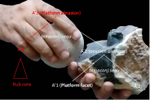
Platforms of Palaeolithic knappers reveal complex linguistic abilitiesCédric Gaucherel and Camille Noûs https://doi.org/10.31233/osf.io/wn5zaThe means of complexity in a lithic reduction sequenceRecommended by Marta Arzarello based on reviews by Antony Borel and 1 anonymous reviewer based on reviews by Antony Borel and 1 anonymous reviewer
The paper entitled “Platforms of Palaeolithic knappers reveal complex linguistic abilities” [1] submitted by C. Gaucherel and C. Noûs represents an interesting reflection about the possibilities to detect the human cognitive abilities in relation to the lithic production. The definition and the study of human cognitive abilities during the Lower Palaeolithic it has always been a complex field of investigation. The relation between the technical skills (lithic production) and the emergence of the linguistic abilities is not easy to investigate due to the difficulty of finding objective data to refer to. The proposition, made by C. Gaucherel and C. Noûs, of a formal grammar of knapping as a method to study the syntactical organisation of the reduction sequences, constitute a new and theoretical useful approach. In order to effectively and precisely define the gestures linked to a specific reduction sequence, for example that of the handaxes shaping, a very large number of variables should be taken into consideration (morphology and quality of the raw material, experience of the knapper, context, percussion technique, forecast of use of the handaxe, etc.). But since a simplification, that brings more elements than the classic one [2,3] is needed, the “action grammar approach” can be a good instrument to detect the common element in a shaping reduction sequence. Furthermore, one of the advantages of the proposed methodology lies in the fact that the definition of the different STs (Stone Technology) can be done according to the technological specific characteristics to be studied and to the type of instrument produced. The deconstruction of knapping sequences could help to detect the degree of complexity of the different steps of the reduction sequences also thanks to the identification of the sub-actions types. The increasing/decreasing of complexity is a very complicate concept in lithic technology. Since at the base of the lithic production there are two basic concepts (angle between the striking platform and the debitage surface - convexity of the debitage/façonnage surface) which are simply declined in an increasingly complex way, it is not easy to define uniquely in what exactly consists the increase in complexity. The approach proposed in the paper “Platforms of Palaeolithic knappers reveal complex linguistic abilities” can help to have new evidences, according to the identification of the required cognitive abilities. The proposed example of formal grammar still needs to be confirmed on archaeological collections, but it is probable that a practical application will allow to further develop the methodology and possibly to highlight additional possibilities of the approach. Bibliography [1] Gaucherel, C. and Noûs C. (2020). Platforms of Palaeolithic knappers reveal complex linguistic abilities. Paleorxiv, wn5za, ver. 6 peer-reviewed and recommended by PCI Archaeology. doi: 10.31233/osf.io/wn5za | Platforms of Palaeolithic knappers reveal complex linguistic abilities | Cédric Gaucherel and Camille Noûs | <p>Recent studies in cognitive neurosciences have postulated a possible link between manual praxis such as tool-making and human languages. If confirmed, such a link opens significant avenues towards the study of the evolution of natural languages... |  | Africa, Ancient Palaeolithic, Lithic technology, Theoretical archaeology | Marta Arzarello | 2020-04-30 14:18:26 | View | |
20 Dec 2020
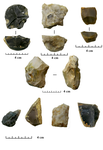
For our world without sound. The opportunistic debitage in the Italian context: a methodological evaluation of the lithic assemblages of Pirro Nord, Cà Belvedere di Montepoggiolo, Ciota Ciara cave and Riparo Tagliente.Marco Carpentieri, Marta Arzarello https://doi.org/10.31219/osf.io/2ptjbInvestigating the opportunistic debitage – an experimental approachRecommended by Alice Leplongeon based on reviews by David Hérisson and 1 anonymous reviewerThe paper “For our world without sound. The opportunistic debitage in the Italian context: a methodological evaluation of the lithic assemblages of Pirro Nord, Cà Belvedere di Montepoggiolo, Ciota Ciara cave and Riparo Tagliente” [1] submitted by M. Carpentieri and M. Arzarello is a welcome addition to a growing number of studies focusing on flaking methods showing little to no core preparation, e.g., [2–4]. These flaking methods are often overlooked or seen as ‘simple’, which, in a Middle Palaeolithic context, sometimes leads to a dichotomy of Levallois vs. non-Levallois debitage (e.g., see discussion in [2]). The authors address this topic by first providing a definition for ‘opportunistic debitage’, derived from the definition of the ‘Alternating Surfaces Debitage System’ (SSDA, [5]). At the core of the definition is the adaptation to the characteristics (e.g., natural convexities and quality) of the raw material. This is one main challenge in studying this type of debitage in a consistent way, as the opportunistic debitage leads to a wide range of core and flake morphologies, which have sometimes been interpreted as resulting from different technical behaviours, but which the authors argue are part of a same ‘methodological substratum’ [1]. This article aims to further characterise the ‘opportunistic debitage’. The study relies on four archaeological assemblages from Italy, ranging from the Lower to the Upper Pleistocene, in which the opportunistic debitage has been recognised. Based on the characteristics associated with the occurrence of the opportunistic debitage in these assemblages, an experimental replication of the opportunistic debitage using the same raw materials found at these sites was conducted, with the aim to gain new insights into the method. Results show that experimental flakes and cores are comparable to the ones identified as resulting from the opportunistic debitage in the archaeological assemblage, and further highlight the high versatility of the opportunistic method. One outcome of the experimental replication is that a higher flake productivity is noted in the opportunistic centripetal debitage, along with the occurrence of 'predetermined-like' products (such as déjeté points). This brings the authors to formulate the hypothesis that the opportunistic debitage may have had a role in the process that will eventually lead to the development of Levallois and Discoid technologies. How this articulates with for example current discussions on the origins of Levallois technologies (e.g., [6–8]) is an interesting research avenue. This study also touches upon the question of how the implementation of one knapping method may be influenced by the broader technological knowledge of the knapper(s) (e.g., in a context where Levallois methods were common vs a context where they were not). It makes the case for a renewed attention in lithic studies for flaking methods usually considered as less behaviourally significant. [1] Carpentieri M, Arzarello M. 2020. For our world without sound. The opportunistic debitage in the Italian context: a methodological evaluation of the lithic assemblages of Pirro Nord, Cà Belvedere di Montepoggiolo, Ciota Ciara cave and Riparo Tagliente. OSF Preprints, doi:10.31219/osf.io/2ptjb [2] Bourguignon L, Delagnes A, Meignen L. 2005. Systèmes de production lithique, gestion des outillages et territoires au Paléolithique moyen : où se trouve la complexité ? Editions APDCA, Antibes, pp. 75–86. Available: https://halshs.archives-ouvertes.fr/halshs-00447352 [3] Arzarello M, De Weyer L, Peretto C. 2016. The first European peopling and the Italian case: Peculiarities and “opportunism.” Quaternary International, 393: 41–50. doi:10.1016/j.quaint.2015.11.005 [4] Vaquero M, Romagnoli F. 2018. Searching for Lazy People: the Significance of Expedient Behavior in the Interpretation of Paleolithic Assemblages. J Archaeol Method Theory, 25: 334–367. doi:10.1007/s10816-017-9339-x [5] Forestier H. 1993. Le Clactonien : mise en application d’une nouvelle méthode de débitage s’inscrivant dans la variabilité des systèmes de production lithique du Paléolithique ancien. Paléo, 5: 53–82. doi:10.3406/pal.1993.1104 [6] Moncel M-H, Ashton N, Arzarello M, Fontana F, Lamotte A, Scott B, et al. 2020. Early Levallois core technology between Marine Isotope Stage 12 and 9 in Western Europe. Journal of Human Evolution, 139: 102735. doi:10.1016/j.jhevol.2019.102735 [7] White M, Ashton N, Scott B. 2010. The emergence, diversity and significance of the Mode 3 (prepared core) technologies. Elsevier. In: Ashton N, Lewis SG, Stringer CB, editors. The ancient human occupation of Britain. Elsevier. Amsterdam, pp. 53–66. [8] White M, Ashton N. 2003. Lower Palaeolithic Core Technology and the Origins of the Levallois Method in North‐Western Europe. Current Anthropology, 44: 598–609. doi:10.1086/377653 | For our world without sound. The opportunistic debitage in the Italian context: a methodological evaluation of the lithic assemblages of Pirro Nord, Cà Belvedere di Montepoggiolo, Ciota Ciara cave and Riparo Tagliente. | Marco Carpentieri, Marta Arzarello | <p>The opportunistic debitage, originally adapted from Forestier’s S.S.D.A. definition, is characterized by a strong adaptability to local raw material morphology and its physical characteristics and it is oriented towards flake production. Its mo... |  | Ancient Palaeolithic, Lithic technology, Middle Palaeolithic | Alice Leplongeon | 2020-07-23 14:26:04 | View | |
17 Dec 2020
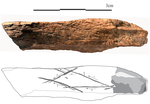
Experimentation preceding innovation in a MIS5 Pre-Still Bay layer from Diepkloof Rock Shelter (South Africa): emerging technologies and symbolsGuillaume Porraz, John E. Parkington, Patrick Schmidt, Gérald Bereiziat, Jean-Philip Brugal, Laure Dayet, Marina Igreja, Christopher E. Miller, Viola C. Schmid, Chantal Tribolo, Aurore Val, Christine Verna, Pierre-Jean Texier https://doi.org/10.32942/osf.io/ch53rExperimentation as a driving force for innovation in the Pre-Still Bay from Southern AfricaRecommended by Anne Delagnes based on reviews by Francesco d'Errico, Enza Elena Spinapolice and Kathryn RanhornThe article submitted by Guillaume Porraz et al. [1] shed light on the evolutionary changes recorded during the Pre-Still Bay Lynn stratigraphic unit (SU) from Diepkloof (Southern Africa). It promotes a multi-proxy and integrative approach based on a set of innovative behaviors, such as the engraving of geometric forms, silcrete heat- treatment, the use of adhesive, bladelet and bifacial tools production. This approach is not so common in Middle Stone Age (MSA) studies and makes a lot of sense for discussing the mechanisms that have fostered later innovations during the Still Bay and Howiesons Poort periods. The various innovations that emerge synchronously in this layer contrast with earlier innovations which appear as isolated phenomena in the MSA archaeological record. The strong inventiveness documented in Lynn SU is reported to a phase of experimentation for testing new ideas, new behaviors that would have played a crucial role for the emergence of the Still Bay in a context of socio-economic transformation. The data presented in this article broadens the scope of two previous articles [2-3] based on a more representative record, collected on an area of 3,5 m² opposed to 2 m² previously, and on the first presentation and description of an engraved bone with a rhomboid pattern. Macro- and microscopic analyses together with the analysis of the distribution of the engraved lines argue convincingly for an intentional engraving. This article constitutes a key contribution to the question of HOW emerged modern cultures in Southern Africa, while calling for further research related to sites’ function, environment and local resources to address the ever-debated question of WHY the MSA groups from Southern Africa developed such unprecedented inventiveness. It makes no doubt that this article deserves recommendation by PCI Archaeology. [1] Porraz, G., Schmidt, P., Bereiziat, G., Brugal, J.Ph., Dayet, L., Igreja, M., Miller, C.E., Viola, C., Tribolo, C., Val, A., Verna, C., Texier, P.J. 2020. Experimentation preceding innovation in a MIS5 Pre-Still Bay layer from Diepkloof Rock Shelter (South Africa): emerging technologies and symbols. 10.32942/osf.io/ch53r [2] Porraz, G., Texier, P.J., Archer, W., Piboule, M., Rigaud, J.P, Tribolo, C. 2013. Technological successions in the Middle Stone Age sequence of Diepkloof Rock Shelter, Western Cape, South Africa. Journal of Archaeological Science 40, 3376–3400. 10.1016/j.jas.2013.02.012 [3] Porraz, G., Texier, J.P. Miller, C.E., 2014. Le complexe bifacial Still Bay et ses modalités d’émergence à l’abri Diepkloof (Middle Stone Age, Afrique du Sud). In: XXVIIème Congrès Préhistorique de France, Transitions, Ruptures et Continuité en Préhistoire. Mémoires de la Société Préhistorique Française, 155–175. | Experimentation preceding innovation in a MIS5 Pre-Still Bay layer from Diepkloof Rock Shelter (South Africa): emerging technologies and symbols | Guillaume Porraz, John E. Parkington, Patrick Schmidt, Gérald Bereiziat, Jean-Philip Brugal, Laure Dayet, Marina Igreja, Christopher E. Miller, Viola C. Schmid, Chantal Tribolo, Aurore Val, Christine Verna, Pierre-Jean Texier | <p>In South Africa, key technologies and symbolic behaviors develop as early as the later Middle Stone Age in MIS5. These innovations arise independently in various places, contexts and forms, until their full expression during the Still Bay and t... |  | Africa, Lithic technology, Middle Palaeolithic, Symbolic behaviours | Anne Delagnes | 2020-08-04 09:13:27 | View | |
08 Feb 2021
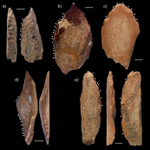
A 115,000-year-old expedient bone technology at Lingjing, Henan, ChinaLuc Doyon, Zhanyang Li, Hua Wang, Lila Geis, Francesco d’Errico https://doi.org/10.31235/osf.io/68xpzA step towards the challenging recognition of expedient bone toolsRecommended by Camille Daujeard based on reviews by Delphine Vettese, Jarod Hutson and 1 anonymous reviewerThis article by L. Doyon et al. [1] represents an important step to the recognition of bone expedient tools within archaeological faunal assemblages, and therefore deserves publication. In this work, the authors compare bone flakes and splinters experimentally obtained by percussion (hammerstone and anvil technique) with fossil ones coming from the Palaeolithic site of Lingjing in China. Their aim is to find some particularities to help distinguish the fossil bone fragments which were intentionally shaped, from others that result notably from marrow extraction. The presence of numerous (>6) contiguous flake scars and of a continuous size gradient between the lithics and the bone blanks used, appear to be two valuable criteria for identifying 56 bone elements of Lingjing as expedient bone tools. The latter are present alongside other bone tools used as retouchers [2]. Another important point underlined by this study is the co-occurrence of impact and flake scars among the experimentally broken specimens (~90%), while this association is seldom observed on archaeological ones. Thus, according to the authors, a low percentage of that co-occurrence could be also considered as a good indicator of the presence of intentionally shaped bone blanks. About the function of these expedient bone tools, the authors hypothesize that they were used for in situ butchering activities. However, future experimental investigations on this question of the function of these tools are expected, including an experimental use wear program. Finally, highlighting the presence of such a bone industry is of importance for a better understanding of the adaptive capacities and cultural practices of the past hominins. This work therefore invites all taphonomists to pay more attention to flake removal scars on bone elements, keeping in mind the possible existence of that type of bone tools. In fact, being able to distinguish between bone fragments due to marrow recovery and bone tools is still a persistent and important issue for all of us, but one that deserves great caution. [1] Doyon, L., Li, Z., Wang, H., Geis, L. and d'Errico, F. 2021. A 115,000-year-old expedient bone technology at Lingjing, Henan, China. Socarxiv, 68xpz, ver. 4 peer-reviewed and recommended by PCI Archaeology. https://doi.org/10.31235/osf.io/68xpz [2] Doyon, L., Li, Z., Li, H., and d’Errico, F. 2018. Discovery of circa 115,000-year-old bone retouchers at Lingjing, Henan, China. Plos one, 13(3), https://doi.org/10.1371/journal.pone.0194318. | A 115,000-year-old expedient bone technology at Lingjing, Henan, China | Luc Doyon, Zhanyang Li, Hua Wang, Lila Geis, Francesco d’Errico | <p>Activities attested since at least 2.6 Myr, such as stone knapping, marrow extraction, and woodworking may have allowed early hominins to recognize the technological potential of discarded skeletal remains and equipped them with a transferable ... |  | Asia, Middle Palaeolithic, Osseous industry, Taphonomy, Zooarchaeology | Camille Daujeard | 2020-11-01 11:09:13 | View | |
28 Feb 2021
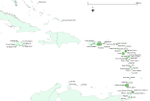
A database of lapidary artifacts in the Caribbean for the Ceramic AgeAlain Queffelec, Pierrick Fouéré, Jean-Baptiste Caverne https://osf.io/preprints/socarxiv/7dq3b/Open data on beads, pendants, blanks from the Ceramic Age CaribbeanRecommended by Ben Marwick based on reviews by Clarissa Belardelli, Stefano Costa, Robert Bischoff and Li-Ying Wang based on reviews by Clarissa Belardelli, Stefano Costa, Robert Bischoff and Li-Ying Wang
The paper 'A database of lapidary artifacts in the Caribbean for the Ceramic Age' by Queffelec et al. [1] presents a description of a dataset of nearly 5000 lapidary artefacts from over 100 sites. The data are dominated by beads and pendants, which are mostly made from Diorite, Turquoise, Carnelian, Amethyst, and Serpentine. The raw material data is especially valuable as many of these are not locally available on the island. This holds great potential for exchange network analysis. The data may be especially useful for investigating one of the fundamental questions of this region: whether the Cedrosan and Huecan are separate, little related developments, with different origins, or variants or a single tradition [2]. In addition to metric and technological details about the artefacts, the data include a variety of locational details, including coordinates, distance to coast, and altitude. This enables many opportunities for future spatial analysis and geostatistical modelling to understand human behaviours relating to ornament production, use, and discard. I recommend the authors make a minor revision to Table 1 (spatial coverage of the dataset) to make the column with the citations conform to the same citation style used in the rest of the text. I warmly commend the authors for making transparency and reproducibility a priority when preparing their manuscript. Their use of the R Markdown format for writing reproducible, dynamic documents [3] is highly impressive. This is an excellent example for others in the international archaeological science community to follow. The paper is especially useful for researchers who are new to R and R Markdown because of the elegant and accessible way the authors document their research here. [1] Queffelec, A., Fouéré, P. and Caverne, J.-B. 2021. A database of lapidary artifacts in the Caribbean for the Ceramic Age. SocArXiv, 7dq3b, ver. 4 Peer-reviewed and recommended by PCI Archaeology. https://doi.org/10.31235/osf.io/7dq3b [2] Reed, J. A. and Petersen, J. B. 2001. A comparison of Huecan and Cedrosan Saladoid ceramics at the Trants site, Montserrat. In Proceedings of the XVIIIth International Congress for Caribbean Archaeology (pp. 253-267). [3] Marwick, B. 2017. Computational Reproducibility in Archaeological Research: Basic Principles and a Case Study of Their Implementation. Journal of Archaeological Method and Theory 24, 424–450. https://doi.org/10.1007/s10816-015-9272-9 | A database of lapidary artifacts in the Caribbean for the Ceramic Age | Alain Queffelec, Pierrick Fouéré, Jean-Baptiste Caverne | <p>Lapidary artifacts show an impressive abundance and diversity during the Ceramic period in the Caribbean islands, especially at the beginning of this period. Most of the raw materials used in this production do not exist naturally on the island... |  | Neolithic, North America, Raw materials, South America, Spatial analysis, Symbolic behaviours | Ben Marwick | 2020-11-13 23:52:34 | View | |
24 Jun 2021
The strength of parthood ties. Modelling spatial units and fragmented objects with the TSAR method – Topological Study of Archaeological RefittingSébastien Plutniak https://osf.io/q2e69A practical computational approach to stratigraphic analysis using conjoinable material culture.Recommended by Hector A. Orengo based on reviews by Robert Bischoff, Matthew Peeples and 1 anonymous reviewerThe paper by Plutniak [1] presents a new method that uses refitting to help interpret stratigraphy using the topological distribution of conjoinable material culture. This new method opens up new avenues to the archaeological use of network analysis but also to assess the integrity of interpreted excavation layers. Beyond its evident applicability to standard excavation practice, the paper presents a series of characteristics that exemplify archaeological publication best practices and, as someone more versed in computational than in refitting studies I would like to comment upon. It was no easy task to find adequate reviewers for this paper as it combines techniques and expertise that are not commonly found together in individual researchers. However, Plutniak, with help from three reviewers, particularly M. Peeples, a leading figure in archaeological applications of network science, makes a considerable effort to be accessible to non-specialist archaeologists. The core Topological Study of Archaeological Refitting (TSAR) method is freely accessible as the R package archeofrag, which is available at the Comprehensive R Archive Network (https://CRAN.R-project.org/package=archeofrag) that can be applied without the need to understand all its mathematical, graph theory and coding aspects. Beside these, an online interface including test data has been provided (https://analytics.huma-num.fr/Sebastien.Plutniak/archeofrag/), which aims to ease access to the method to those archaeologists inexperienced with R. Finally, supplementary material showing how to use the package and evaluating its potential through excellent examples is provided as both pdf and Rmw (Sweave) files. This is an important companion for the paper as it allows a better understanding of the methods presented in the paper and its practical application. The author shows particular care in testing the potential and capabilities of the method. For example, a function is provided “frag.observer.failure” to test the robustness of the edge count method against the TSAR method, which is able to prove that TSAR can deal well with incomplete information. As a further step in this direction both simulated and real field-acquired data are used to test the method which further proves that archeofrag is not only able to quantitatively assess the mixture of excavated layers but to propose meaningful alternatives, which no doubt will add an increased methodological consistency and thoroughness to previous quantitative approaches to material refitting work, even when dealing with very complex stratigraphies. All in all, this paper makes an important contribution to core archaeological practice through the use of innovative, reproducible and accessible computational methods. I fully endorse it for the conscious and solid methods it presents but also for its adherence to open publication practices. I hope that it can become of standard use in the reconstruction of excavated stratigraphical layers through conjoinable material culture.
[1] Plutniak, S. 2021. The Strength of Parthood Ties. Modelling Spatial Units and Fragmented Objects with the TSAR Method – Topological Study of Archaeological Refitting. OSF Preprints, q2e69, ver. 3 Peer-reviewed and recommended by PCI Archaeology. https://doi.org/10.31219/osf.io/q2e69. | The strength of parthood ties. Modelling spatial units and fragmented objects with the TSAR method – Topological Study of Archaeological Refitting | Sébastien Plutniak | <p>Refitting and conjoinable pieces have long been used in archaeology to assess the consistency of discrete spatial units, such as layers, and to evaluate disturbance and post-depositional processes. The majority of current methods, despite their... | Computational archaeology, Taphonomy | Hector A. Orengo | 2021-01-14 18:31:01 | View | ||
15 Aug 2021
Ran-thok and Ling-chhom: indigenous grinding stones of Shertukpen tribes of Arunachal Pradesh, IndiaNorbu Jamchu Thongdok, Gibji Nimasow & Oyi Dai Nimasow https://doi.org/10.5281/zenodo.5118675An insight into traditional method of food production in IndiaRecommended by Otis Crandell based on reviews by Antony Borel, Atefeh Shekofteh, Andrea Squitieri, Birgül Ögüt, Atefe Shekofte and 1 anonymous reviewerThis paper [1] covers an interesting topic in that it presents through ethnography an insight into a traditional method of food production which is gradually declining in use. In addition to preserving traditional knowledge, the ethnographic study of grinding stones has the potential for showing how similar tools may have been used by people in the past, particularly from the same geographic region. [1] Thongdok Norbu J., Nimasow Gibji, Nimasow Oyi D. (2021) Ran-thok and Ling-chhom: indigenous grinding stones of Shertukpen tribes of Arunachal Pradesh, India. Zenodo, 5118675, ver. 4 peer-reviewed and recommended by PCI Archaeo. doi: https://doi.org/10.5281/zenodo.5118675 | Ran-thok and Ling-chhom: indigenous grinding stones of Shertukpen tribes of Arunachal Pradesh, India | Norbu Jamchu Thongdok, Gibji Nimasow & Oyi Dai Nimasow | <p style="text-align: justify;">The Shertukpens are an Indigenous tribal group inhabiting the western and southern parts of Arunachal Pradesh, Northeast India. They are accomplished carvers of carving wood and stone. The paper aims to document the... | Antiquity, Asia, Environmental archaeology, Lithic technology, Peopling, Raw materials | Otis Crandell | 2021-02-10 10:26:12 | View | ||
11 Jan 2022
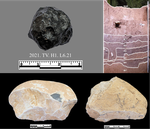
Tektite geoarchaeology in mainland Southeast AsiaBen Marwick, Son Thanh Pham, Rachel Brewer, Li-Ying Wang https://doi.org/10.31235/osf.io/93fpaTektites as chronological markers: after careful geoarchaeological validation only!Recommended by Alain Queffelec and Shanti Pappu based on reviews by Sheila Mishra, Toshihiro Tada, Mike Morley and 1 anonymous reviewer and Shanti Pappu based on reviews by Sheila Mishra, Toshihiro Tada, Mike Morley and 1 anonymous reviewer
Tektites, a naturally occurring glass produced by major cosmic impacts and ejected at long distances, are known from five impacts worldwide [1]. The presence of this impact-generated glass, which can be dated in the same way as a volcanic rock, has been used to date archaeological sites in several regions of the world. This paper by Marwick and colleagues [2] reviews and adds new data on the use and misuse of this specific material as a chronological marker in Australia, East and Southeast Asia, where an impact dated to 0.78 Ma created and widely distributed tektites. This material, found in archaeological excavations in China, Laos, Thaïland, Australia, Borneo, and Vietnam, has been used to date layers containing lithic artifacts, sometimes creating a strong debate about the antiquity of the occupation and lithic production in certain regions. The review of existing data shows that geomorphological data and stratigraphic integrity can be questioned at many sites that have yielded tektites. The new data provided by this paper for five archaeological sites located in Vietnam confirm that many deposits containing tektites are indeed lag deposits and that these artifacts, thus in secondary position, cannot be considered to date the layer. This study also emphasizes the general lack of other dating methods that would allow comparison with the tektite age. In the Vietnamese archaeological sites presented here, discrepancies between methods, and the presence of historical artifacts, confirm that the layers do not share similar age with the cosmic impact that created the tektites. Based on this review and these new results, and following previous propositions [3], Marwick and colleagues conclude that, if tektites can be used as chronological markers, one has to prove that they are in situ. They propose that geomorphological assessment of the archaeological layer as primary deposit must first be attained, in addition to several parameters of the tektites themselves (shape, size distribution, chemical composition). Large error can be made by using only tektites to date an archaeological layer, and this material should not be used solely due to risks of high overestimation of the age of the archaeological production. [1] Rochette, P., Beck, P., Bizzarro, M., Braucher, R., Cornec, J., Debaille, V., Devouard, B., Gattacceca, J., Jourdan, F., Moustard, F., Moynier, F., Nomade, S., Reynard, B. (2021). Impact glasses from Belize represent tektites from the Pleistocene Pantasma impact crater in Nicaragua. Communications Earth & Environment, 2(1), 1–8, https://doi.org/10.1038/s43247-021-00155-1 [2] Marwick, B., Son, P. T., Brewer, R., Wang, L.-Y. (2022). Tektite geoarchaeology in mainland Southeast Asia. SocArXiv, 93fpa, ver. 6 peer-reviewed and recommended by PCI Archaeology, https://doi.org/10.31235/osf.io/93fpa. [3] Tada, T., Tada, R., Chansom, P., Songtham, W., Carling, P. A., Tajika, E. (2020). In Situ Occurrence of Muong Nong-Type Australasian Tektite Fragments from the Quaternary Deposits near Huai Om, Northeastern Thailand. Progress in Earth and Planetary Science 7(1), 1–15, https://doi.org/10.1186/s40645-020-00378-4 | Tektite geoarchaeology in mainland Southeast Asia | Ben Marwick, Son Thanh Pham, Rachel Brewer, Li-Ying Wang | <p>Tektites formed by an extraterrestrial impact event in Southeast Asia at 0.78 Ma have been found in geological contexts and archaeological sites throughout Australia, East and Southeast Asia. At some archaeological sites, especially in Bose Bas... |  | Asia, Geoarchaeology | Alain Queffelec | 2021-08-14 18:04:18 | View |
MANAGING BOARD
Alain Queffelec
Marta Arzarello
Ruth Blasco
Otis Crandell
Luc Doyon
Sian Halcrow
Emma Karoune
Aitor Ruiz-Redondo
Philip Van Peer










